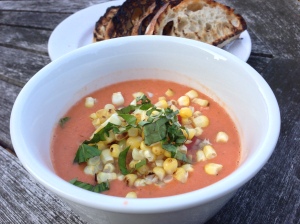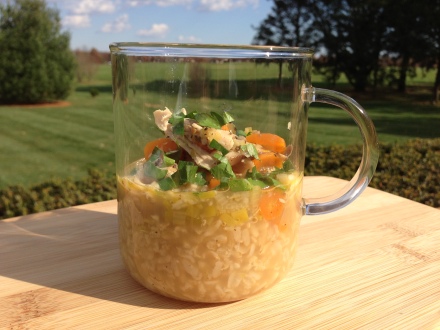It’s funny the things we take at face value. My exposure to ethnic Laotian cooking, for instance. The rural central Pennsylvanian community in which I grew up during the 1970s and early 1980s wasn’t, as I’ve written before in my Chile Rellenos post, the most ethnically diverse area of the country. But through my family’s active involvement in social groups and other community affiliations we seemed to always be among a handful of residents welcoming newcomers to our town.
As the war in Southeast Asia came to and end in the mid 1970s and Communist governments formed in the region, refugees from Vietnam, Thailand, and Laos repatriated to other countries. Quite a few Laotian refugees — many of whom were of Hmong ethic origin — emigrated to the United States. One of the churches in our little town sponsored a Laotian family and, predictably, my family started to spend a lot of time with them. Maybe it was my mother’s background as a teacher (even retired, she still volunteers to teach English as a Second Language), or maybe it was my father’s ties with the Kiwanas Club members who almost certainly helped find housing and jobs for the new family, but I remember many afternoons that year bonding not over a shared language, but a shared love of cooking and food. As a young elementary schooler I didn’t question any of it — that we communicated in ways other than typical conversation seemed, strangely, normal.
One of the dishes our new Laotian friends taught us was a marinated chicken dish with strong Chinese influences: drumsticks soaked in soy sauce and ginger and then grilled over an open flame.

Drumsticks on the grill, indirect heat
Some time passed, the Laotian family moved to be closer to relatives, and then eventually my family relocated to Southeast Pennsylvania during my last year of elementary school. But this dish has always traveled along with us. My parents still make it, and now, so do I. It has a way of both taking me back and anchoring me in the present as I adapt it over and over again, serving it to my husband and daughters and our friends. And now, also sharing it with you.
It’s easy, inexpensive, and soooo good. Make it once and I guarantee you’ll make it again, and now you also have a kind-of cool story to tell anyone for whom you prepare it — a simple dish that traveled from Laos that is so much more than it appears at face value.

Soy-Ginger-Garlic Drumsticks
Grilled Soy-Ginger-Garlic Drumsticks
Ingredients:
3 pounds chicken drumsticks, skin removed
1/2 cup good quality soy sauce (low sodium if you have it — regular soy sauce produces pretty salty drumsticks, which is fine if you like that sort of thing)
Knob of ginger root approximately two inches long, cut into eight 1/4 inch disks
1 garlic clove, sliced into rounds*
1 teaspoon grated lemon zest – optional*
Cooked white rice for serving
You’ll get the best results if you begin to prepare this recipe the day before you plan to serve it…or at least early the same day so the chicken has time to marinate. At least 3 hours, and up to 24 hours.
In a quart size zip-top bag placed inside a medium bowl, combine the chicken, soy sauce, ginger, garlic and lemon zest if you’re using it. Squeeze out extra air and seal the bag. Massage the liquid around the drumsticks, place the bag in the bowl and put the whole lot into the refrigerator. You don’t NEED to use the bowl, but I’ve had zip-top bags spring leaks, and this at least keeps the mess contained if it does. Allow the chicken to marinate, periodically — and carefully! — shaking the bag so that the soy/ginger/garlic evenly penetrates the drumsticks.

The essential ingredients: soy sauce, ginger and garlic
About 45 minutes before you’re ready to eat, prepare your grill for indirect grilling and include a drip pan or sheet of tinfoil on the indirect side (see my earlier post on hickory-smoked chicken thighs if you have questions). When the grill reaches a temperature between 350 degrees and 400 degrees, put the drumsticks on the side with the drip pan. Cover to bring the grill back up to temperature and grill for 15 minutes before flipping the drumsticks and grilling, covered, for another 15 minutes.
When chicken is cooked through, remove from the grill and allow to rest for 10 minutes before serving. Great with rice and a quick pickled cucumber dish or other veggie dish with a little vinegar.
This recipe can easily be doubled to feed a crowd. Try it with chicken thighs as well – equally good.
Serves: six.

Chopsticks, drumsticks….
Parent rating: Four-and-a-half stars. I love this recipe. We must make it every several weeks or so during grilling season. Sometimes I leave the chicken skin on the drumsticks (the soy marinade doesn’t penetrate as much). Great for backyard barbecues or pot luck suppers. Leftovers are great too and can be used in a variety of ways…but more on that in another post!
Kid rating: Four stars. Daughter 2 polished off three of these drumsticks before I finished one the night we most recently made them…and she’s young enough that the novelty of eating chicken on a bone is actually fun. Daughter 1 finished one drumstick — enough to make me happy — but isn’t the biggest meat-eater anyway. The rice and sides, on the other hand…gone.
* The original recipe did not use garlic or lemon zest; I often just make this with soy and ginger myself, but the garlic adds a nice depth and flavor and lemon, when I use it, has a nice bright citrus quality. Mince the garlic for more potent garlic taste.






















